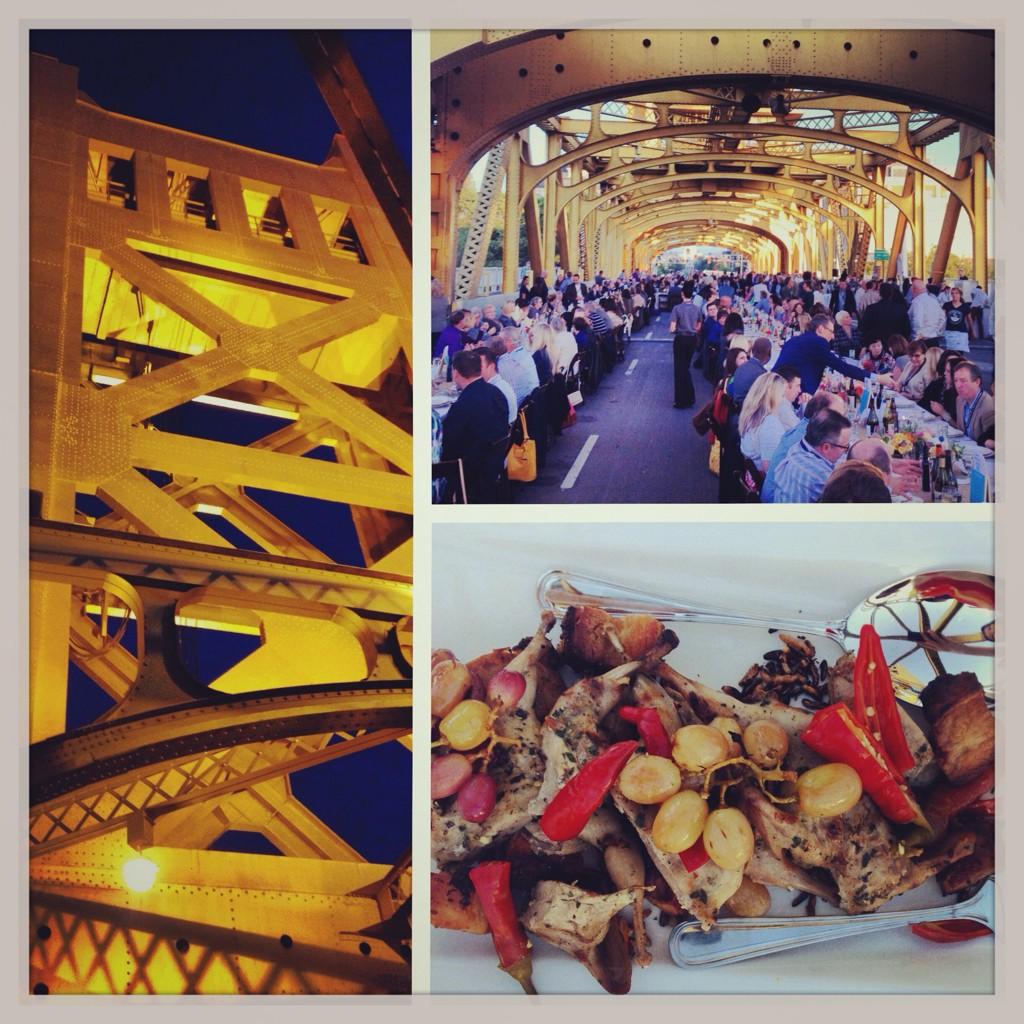Low Income and Jobless Forgotten as City Leaders go Pinky-Up
Last weekend, Sacramento City leaders shut down the Tower Bridge to host Sacramento elite at a dinner to celebrate their self-designated "Farm to Fork Capitol" of America. This gala dinner, which cost between $175 and $625 per person (depending on how close to the King you wanted to sit), capped off two weeks of self-indulgent faux service to the Sacramento community. Sacramento's leading couple, Kevin Johnson and Angelique Ashby were in attendance.
The inappropriateness of this event was noted in the Sacramento Bee and Sacramento News & Review, among other places. Each recognized that with a median household income of $55,000, farm to fork groceries are a stretch on the budget, and this event was just over-the-top.
What this celebration highlighted most of all is the low wages and poverty that pervades significant portions of Sacramento. In the City of Sacramento, more than one-fourth of residents live below the poverty level, compared to one-fifth statewide. Local farmers markets throughout our communities have been a welcome staple of Sacramento since long before City leaders decided to politically capitalize on the backs of local growers. However, fresh fruits and vegetables, grass-fed beef, and ranch-made cheese and butter are normally too pricey for struggling families to eat more than a couple times each month.
Promoters of "organic" produce and locally grown products tend to brush aside this simple economic fact, saying, "sure it's a little more expensive, but it's better for you". For families who know exactly how much money is in their bank account - to the penny - because they need every penny to eat and survive, eating "better" just isn't part of the equation. The struggle is to survive, and City leaders aren't helping ease that struggle.
If City leaders are going to go through the time, expense, and public inconvenience of holding a two-week festival and shutting down a major thoroughfare in Sacramento, shouldn't that event focus on creating jobs and economic opportunities for the 40,000+ Sacramentans unemployed and looking for jobs, or the 58,000 Sacramentans out of work and collecting social security disability? City leaders regularly extol the virtues of Farm to Fork, a new Entertainment Sports Complex, and recently a new MLS Soccer Stadium, but when was the last time you heard them talk about the rest of us.
The rest of us are those that are taking care of our families and making ends meet. The rest of us are the 125,000 that are struggling with a wage less than $24,000/yr for a family of four (25.6%). The rest of us are the 40,000 that are out of work, but desperately looking for a job (8.4%). The rest of us are the thousands of college graduates that must spend two hours of their day (that could be spent with family) commuting to the bay area, because there are no opportunities for them in Sacramento.
The rest of us aren't paying for the privilege of sitting next to the man who wants all of the power (http://yesonmeasurel.org/), and the rest of us aren't developers making billions on large City-promoted projects. The rest of us are voters and taxpayers, though.
Labels:
ashby,
City,
city council,
cohn,
development,
economy,
Entertainment Sports Complex,
ESC,
fong,
hansen,
mayor,
measure l,
poverty,
schenirer,
unemployment,
warren
The Future of Sacramento Development - General Plan Update 2035
Another key component to Sacramento's future success is planning for development. This is the second article discussing the 2035 General Plan Update released in August 2014.
According to city leaders, the city intends to "encourage compact, higher-density development..." (LU 1.1.1). Throughout the city, they intend to build up - not out. The premise behind such a proposal is that not enough Sacramentans live in multi-unit apartment buildings. Among the stated purposes for this requirement to increase density are: supporting transit, reducing vehicle trips, promoting pedestrian/bicycle friendly neighborhoods, and increasing housing diversity.
Now I, personally, want to see Sacramento make the transition into "big city" status. There is currently estimated to be more than 475,000 residents in the City of Sacramento. There are only a handful of cities in California bigger than Sacramento, as reported by the California Department of Finance. This places Sacramento as the 7th largest city in California, following: Los Angeles (3,904k), San Diego (1,345k), San Jose (1,000k), San Francisco (836k), and Fresno (515k).
But, in order to break into big city status alongside northern California giants like San Francisco and San Jose, there must be fundamental change - change that has long been met with less-than-enthusiastic response from residents who like to think of Sacramento as a "cow town" (see Here, Here and Here). There's something to be celebrated about having a reputation for nice people, slower pace, and urban farms and livestock.
When you get down to it, here's the crux of the argument for greater infill development and higher housing densities. The percentage of buildings with five or more units in Sacramento is about 22.5% - Now, compare this with Los Angeles (45.5%), San Diego (35.5%), San Jose (25%), and San Francisco (45.5%). It simply can't be said that the City's skyline rivals that of San Francisco, San Jose or Los Angeles.
City leaders have a schizophrenic vision of shedding Sacramento's cow town reputation in favor of tightly-packed residents, robust transit and non-motorized transportation options, while still promoting agriculture (lately with the "Farm to Fork" fad) and open space (LU 2.3.1). It makes one wonder whether they're trying to appease the voters (who like the "small town" feel), while still pushing a big city agenda.
According to city leaders, the city intends to "encourage compact, higher-density development..." (LU 1.1.1). Throughout the city, they intend to build up - not out. The premise behind such a proposal is that not enough Sacramentans live in multi-unit apartment buildings. Among the stated purposes for this requirement to increase density are: supporting transit, reducing vehicle trips, promoting pedestrian/bicycle friendly neighborhoods, and increasing housing diversity.
 |
| Sacramento's Big City Skyline |
 |
| A whole different "cowtown" world |
When you get down to it, here's the crux of the argument for greater infill development and higher housing densities. The percentage of buildings with five or more units in Sacramento is about 22.5% - Now, compare this with Los Angeles (45.5%), San Diego (35.5%), San Jose (25%), and San Francisco (45.5%). It simply can't be said that the City's skyline rivals that of San Francisco, San Jose or Los Angeles.
City leaders have a schizophrenic vision of shedding Sacramento's cow town reputation in favor of tightly-packed residents, robust transit and non-motorized transportation options, while still promoting agriculture (lately with the "Farm to Fork" fad) and open space (LU 2.3.1). It makes one wonder whether they're trying to appease the voters (who like the "small town" feel), while still pushing a big city agenda.













